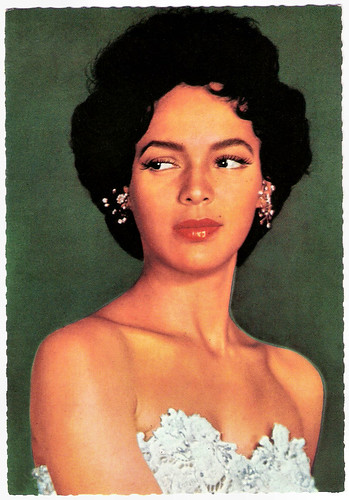
German postcard by ISV. Photo: 20th Century Fox. Publicity still for Carmen Jones (Otto Preminger, 1954).

Italian postcard by Turismofoto, no. 62. Photo: 20th Century Fox. Dorothy Dandridge in Carmen Jones (Otto Preminger, 1954).

Vintage photo.

German collectors card by Ufa/Film-Foto, no. 18. Photo: Gérard Décaux. Dorothy Dandridge in Tamango (John Berry, 1958).
The Wonder Children
Dorothy Jean Dandridge was born in, 1922 in Cleveland, Ohio, to Ruby Dandridge (née Ruby Jean Butler), a stage and screen actress, and Cyril H. Dandridge, a cabinet maker and minister. Under the prodding of her mother, Dorothy and her sister, Vivian Dandridge, began performing publicly as a song-and-dance duo, the Wonder Children, usually in black Baptist churches throughout the country. Her mother would often join her daughters on stage and the act was later called The Dandridge Sisters.
During the crisis, they moved to Los Angeles and worked with the Jimmie Lunceford Orchestra and Cab Calloway. In Hollywood, The Dandridge Sisters received a cameo in the film The Big Broadcast of 1936 (Norman Taurog, 1935). Subsequent film roles, including a bit role in the Marx Brothers' comedy, A Day at the Races (Sam Wood, 1937), led to the two being booked for the prestigious Cotton Club in New York.
The Dandridge Sisters turned up with Louis Armstrong and Maxine Sullivan in the film Going Places (Ray Enright, 1939). Dandridge started performing solo in the early 1940s. In 1941 and 1942, she appeared in soundies, a precursor to the music video. In these soundies, she sang her hits, mostly cover versions of hits by other artists, such as 'Paper Doll' by the Mills Brothers, 'Cow Cow Boogie' by Freddie Slack and Ella Mae Morse, and 'Jig in the Jungle' and 'Mr. & Mrs. Carpenter's Rent Party'.
She also performed in several features in the same years, including Sun Valley Serenade (H. Bruce Humberstone, 1942) with Sonja Henie, during the production of which Dorothy met her first husband, the dancer Harold Nicholas. After her marriage ended in a divorce she became popular and famous as a sultry nightclub entertainer. Dorothy performed as a vocalist in the Apollo Theater and was the first black woman to perform at the Waldorf-Astoria Hotel. Then she began to make her mark in films with her notable appearance in Tarzan's Peril (Byron Haskin, 1951), in which she played a sexy African princess opposite Lex Barker.
Her breakthrough was her title role in the all-black production of Carmen Jones (Otto Preminger, 1954). Dandridge's performance as the sultry title character made her one of Hollywood's first African-American sex symbols. Carmen Jones became a worldwide success, eventually earning over $10 million at the box office and becoming one of the year's highest-earning films. After Hattie McDaniel and Ethel Waters, Dandridge was the third African-American to receive an Oscar nomination, though the first for Best Actress. When she appeared on the cover of Life magazine in 1955, she seemed destined to become the first non-white film star. Yet she was offered few roles.
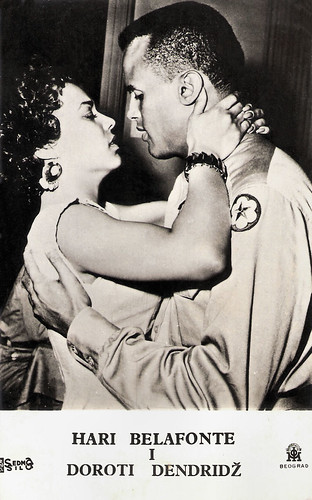
Yugoslavian postcard by IOM, Beograd. Photo: Sedma Sila. Publicity still for Carmen Jones (Otto Preminger, 1954) with Harry Belafonte.

West-German postcard by Kolibri-Verlag G.m.b.H., Minden-Westf, no. 2208. Photo: 20th Century Fox. Dorothy Dandridge in Carmen Jones (Otto Preminger, 1954).

German postcard by Kunst und Bild, no. T 862. Photo: 20th Century Fox. Publicity still for Island in the Sun (Robert Rossen, 1957).
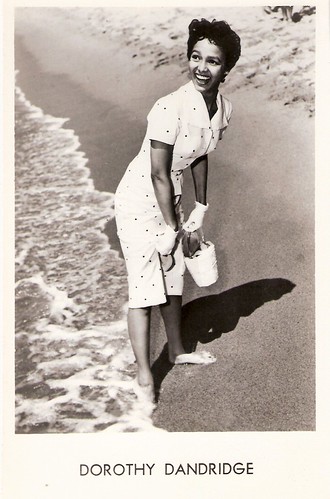
Vintage postcard, no. 2022.
An extremely intimate loving embrace
In 1957, after a three-year absence from film acting, Dorothy Dandridge agreed to appear in the film version of Island in the Sun (Robert Rossen, 1957), opposite an ensemble cast, including James Mason, Harry Belafonte, Joan Fontaine, Joan Collins, and Stephen Boyd.
Island in the Sun was controversial for its time, and the script was revised numerous times to accommodate the Production Code requirements about interracial relationships. There occurred, however, an extremely intimate loving embrace between Dandridge and John Justin that succeeded in not breaching the code. Despite the behind-the-scenes controversy and unfavourable critical reviews, the film was one of the year's biggest successes.
Dandridge next starred opposite Curd Jürgens in the Italian production of Tamango (John Berry, 1958). A reluctant Dandridge had agreed to appear in the film only after learning that it focused on a nineteenth-century slave revolt on a cargo ship travelling from Africa to Cuba.
However, Dandridge nearly withdrew her involvement when the initial script called for her to swim in the nude and spend the majority of the film in a two-piece bathing suit made of rags. When Dandridge threatened to leave the film, the script and her wardrobe were retooled to her liking.
In 1959, she was nominated for a Golden Globe Award for Porgy and Bess (Otto Preminger, 1959). However, when the film was released, it was critically bashed and failed to recoup its financial investment.

German postcard by WS-Druck, Wanne-Eickel, no. F 106. Photo: 20th Century Fox / Filmpress Zürich. Publicity still for Island in the Sun (Robert Rossen, 1957).

Dutch postcard by DRC, no. 3796. DRC, Holland, was the license holder for Ufa in Belgium and Belgian Congo. Photo: 20th Century Fox. Dorothy Dandridge in Island in the Sun (Robert Rossen, 1957).
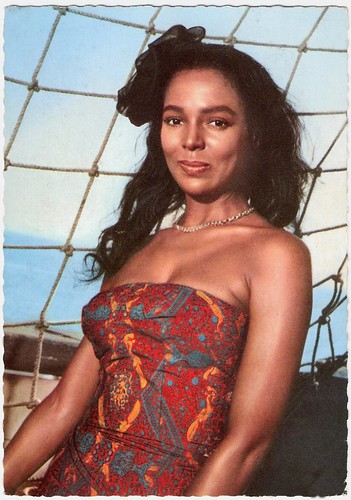
West-German postcard by Ufa (Universum-Film Aktiengesellschaft), Berlin-Tempelhof, no. CK-129. Retail price: 30 Pfg. Photo: Gérard Décaux. Publicity still for Tamango (John Berry, 1958).
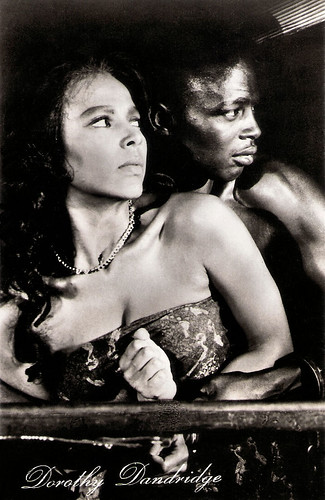
East-German postcard by VEB Progress Film-Vertrieb, Berlin, no. 1276, 1960. Photo: publicity still for Tamango (John Berry, 1958) with Alex Cresson.
Mysterious circumstances
Dorothy Dandridge next filmed a low-budget British thriller, Malaga (László Benedek, 1960) in which she played a European woman with an Italian name. The film, co-starring Trevor Howard and Edmund Purdom, plotted a jewel robbery and its aftermath.
Howard and Dandridge created some strongly understated sexual tension in the film. Malanga was withheld from a theatrical release abroad until 1960 but went unreleased in the United States until 1962. It was her final completed film appearance.
Dandridge was married and divorced twice. From 1942 to 1951, she was married to dancer and entertainer Harold Nicholas of the Nicholas Brothers. They had a daughter, Harolyn Suzanne Nicholas, who was born brain-damaged.
In 1959 she married hotel owner Jack Denison. They divorced in 1962 amid financial setbacks and allegations of domestic violence. At this time, Dandridge discovered that the people who were handling her finances had swindled her out of $150,000 and that she was $139,000 in debt for back taxes. As a result of personal bankruptcy, she placed her child in a psychiatric hospital and sold her house in Hollywood. Afterwards, she sank into depression and sought refuge in alcohol.
With the help of her manager Earl Mills, she tried to resume her career as a nightclub singer, but on 8 September 1965, Dandridge was found dead in her bathroom. She was 42. Opinions are divided about the true cause of death. Some pathologists believe she died of an unintentional overdose of antidepressants[1] while others believe she suffered a pulmonary and cerebral embolism as a result of a foot fracture sustained five days earlier. She is the subject of the HBO biographical film, Introducing Dorothy Dandridge (Martha Coolidge, 1999) with Halle Berry.

American Arcade card.
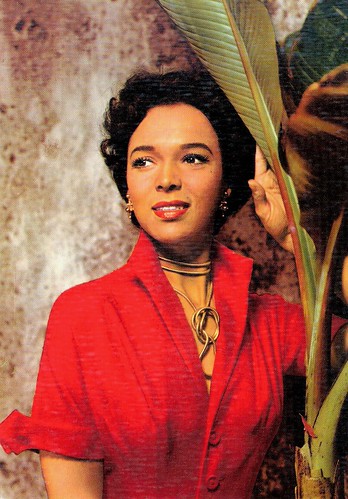
Italian postcard by Rotalfoto, Milano, no. 82.
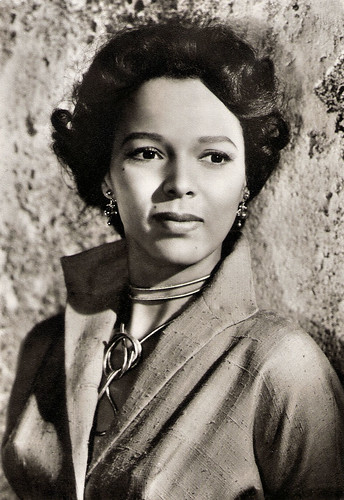
German postcard by Ufa, Berlin-Tempelhof, WP no. 14. Photo: Centfox.

West-German postcard by WS-Druck, Wanne-Eickel, no. 179. Photo: dpa / Centfox.
Clip from Tamango (John Berry, 1958). Source: ClassicBlackCinema's channel (YouTube).
Sources: AllMovie, Wikipedia and IMDb.
This post was last updated on 23 November 2023.
No comments:
Post a Comment